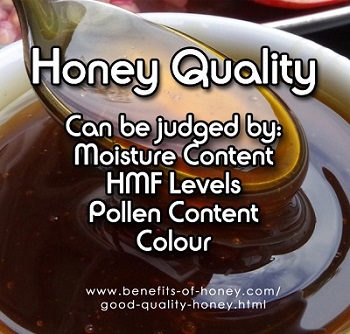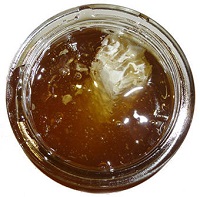
5 Ways to Judge Good Quality Honey
What is considered as good quality honey? Even after deciding that a certain floral variety of honey would be your most favourite type of honey, many of us are often still left with the question of "How do I choose a particular floral variety of honey amongst all the countless brands and prices of honey from all over the world?" While there is no clear standard on what constitutes good honey, the quality of honey can be judged by the following factors in the laboratory.
1. Water Content
Some people believe that good quality honey essentially has a low water content as honey is likely to ferment and lose its freshness if its water content, which can be measured using a gadget called refractometer, is greater than 19%. All unpasteurized, raw honey contains wild yeasts. Due to the high sugar concentration, these yeasts will pose little risk in low moisture honey because osmosis will draw sufficient water from the yeast to force them into dormancy. However, in honey that has a higher proportion of water, there is a higher chance that the yeast may cause fermentation in storage, whereby the increase of acidity can become a quality issue for the honey.

Honey is hygroscopic, which means that it easily absorbs moisture from the air. Thus, in areas with a very high humidity it can be difficult to produce honey of relatively low water content. Raw honey's moisture content can be as low as 14%, and is deemed by some as more valuable (Wikipedia, Honey). Honey containing up to 20% water is not recommended for mead-making. One simple way of judging the relative quantity of water (not purity) in honey involves taking two same-size, same-temperature, well-sealed jars of honey from different sources. Turn the two jars upside-down and watch the bubbles rise. Bubbles in the honey with more water content will rise faster.
2. HMF(Hydroxymethylfurfural)
HMF is a break-down product of fructose (one of the main sugars in honey) formed slowly during storage and very quickly when honey is heated. The amount of HMF present in honey is therefore used as a guide to storage length and the amount of heating which has taken place.
HMF's occurrence and accumulation in honey is variable depending on honey type. High levels of HMF may indicate excessive heating during the extraction process. Honey that is traded in a bulk form is usually required to be below 10 or 15mg/kg to enable further processing and then give some shelf life before a level of 40 mg/kg is reached. It is not uncommon for honey sold in hot climates to be well over 100 mg/kg in HMF. This is mostly due to the ambient temperatures (over 35°C) that honey is exposed to in the distribution channel. Some countries set an HMF limit for imported honey. You may also want to note the colour of the honey as it sometimes may be an indicator of the length of storage or amount of exposure to heat.
3. Inverted Sugars
High levels of HMF (greater than 100 mg/kg) can also be an indicator of adulteration with inverted sugars. Cane sugar or sucrose, is "inverted" by heating with a food acid, and this process creates HMF. Many food items sweetened with high fructose corn syrups, e.g. carbonated soft drinks, can have levels of HMF up to 1,000 mg/kg

4. Pollen
For many consumers, good quality honey is expected to be visually free of defect -- clean and clear. Honey which has a good pollen content appears cloudy, and the presence of many other contaminations such as particles of wax, bees, splinters of wood, and dust certainly does make it look unappetising and unappealing for anyone to buy and consume, and hence it appears as if it's of very low value. Unfortunately, no matter how much food value or health benefits some of these particles like pollen can offer, this kind of honey is hard to be associated with good quality honey and is immediately rejected by most consumers at the super-mart. And this explains why it's almost impossible to find unfiltered, raw honey on the shelf. Its cloudy appearance makes them commercially unattractive.
Nevertheless, honey can be tested for its authenticity based on the presence of pollen. Using a trace spore, pollen grains are identified and counted. The type and quantity of pollen spores determine the origin of honey. It is believed that honey illegally imported from China is microfiltered so that once pollen is removed, there is no way of determining the origin of honey. And such honey can be mislabeled as "local honey" and tagged with a high price..
5. Colour
Honey is color graded into light, amber, and dark categories which do not really have any bearing on quality. Some of the most distinctively and strongly flavored honey varieties, such as basswood, are very light, while very mild and pleasant honeys such as tulip poplar can be quite dark. Honey color is measured on the Pfund Scale in millimeters. While it is not an indicator of honey quality and there are exceptions to the rule, generally speaking, the darker color the honey, the higher its mineral contents, the pH readings, and the aroma/flavor levels. Minerals such as potassium, chlorine, sulfur, iron, manganese, magnesium, and sodium have been found to be much higher in darker honeys.
Related Pages
1. How can you be sure that the honey you bought is not diluted and added with sugar? Are you able to differentiate 100% pure honey and adulterated honey from home? Read Are These 4 Ways to Test for Pure Honey Valid?
2. Everyone wants to eat the best honey. But what's the best?
3. Raw honey, local honey, pure honey, or organic honey... which do you think is the best, how do you pick? More in: Which Honey to Buy?
4. To test for real honey, this bubbling test has been suggested by many honey aficionados and beekeepers, so let us see how convincing the results are in: Test for Real Honey - Bubbling Test.
End of "5 Ways to Judge Good Quality Honey". Back to Quick Honey Facts.